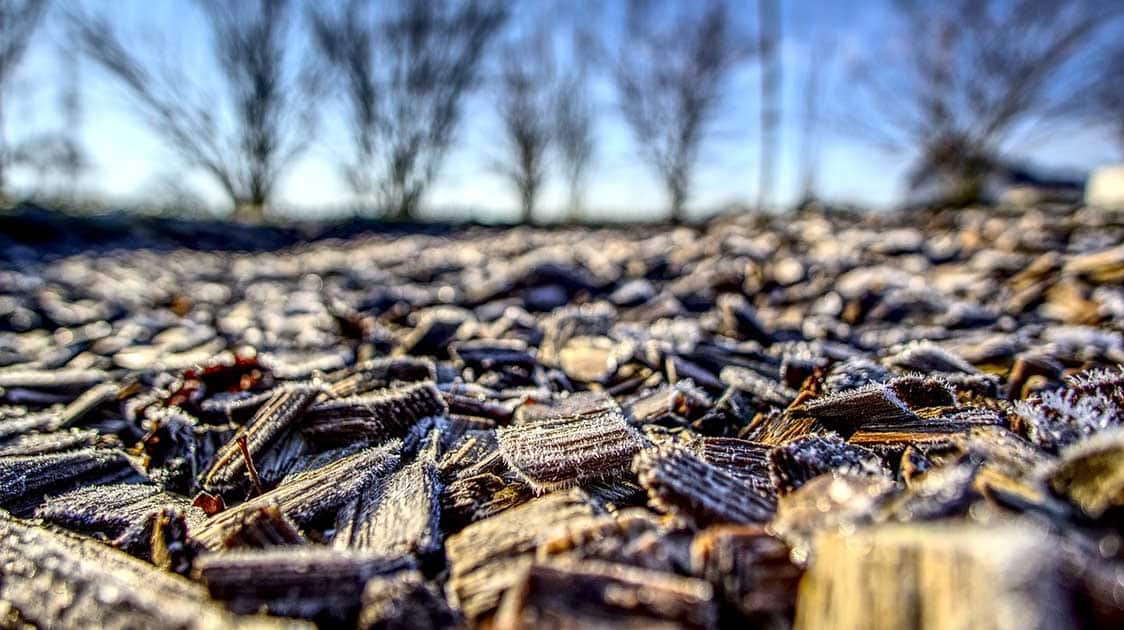
Mulch is the unsung hero of the home garden. Shrubs, flowers, and vegetables all depend on well-hydrated and nutrient soil as do trees of course. What’s one secret to keeping soil happy? You guessed it: mulch.
Mulch has so many great benefits which we dive into below. You can buy mulch from home and garden stores which are usually large bags of wood chips. You can also simply make your own mulch by collecting and repurposing organic matter found in your own yard, including leaves, grass clippings, and branches.
Find out why young trees need mulch below!
What is mulch
There are two basic kinds of mulch: organic and inorganic. Organic mulches include formerly living material such as chopped leaves, straw, grass clippings, compost, wood chips, shredded bark, sawdust, pine needles, and even paper. This is the type of mulch we will be writing about today.
Inorganic mulches include black plastic and geotextiles (landscape fabrics). Both types of mulch discourage weeds, but organic mulches also improve the soil as they decompose, which is great for your Bios Urn ® tree!
Why young trees need mulch
Other than watering, there’s arguably nothing better you could do to help your new tree get established than add a layer of mulch.
Mulch can hold available moisture to feed growing tree roots. In very hot climates, even rocks can be used to shade soil and make condensation available for tree roots, but rocks don’t do nearly as much in terms of imparting nutrition as organic mulches do.
In addition, mulches moderate soil temperature to help contribute to vigorous root growth. Young roots will happily grow into loose soil, but have a harder time punching through the hard-packed clay we often find in urban environments. They’ll grow even more enthusiastically into loose soil that is moist and held to a moderate temperature.
Another way that it contributes to creating good conditions for root growth is by helping maintain temperatures conducive to root growth. When a tree is well-mulched, the soil around its roots is slightly warmer during the winter and slightly cooler during the summer. This happens naturally in a forest as twigs and leaves constantly shower the forest floor, so we’re simply recreating what young trees find in a more natural setting to ensure they thrive in years to come.
If that’s not enough, mulch helps to suppress weed growth, fosters growth and development of soil microbial activity and is a great way to recycle organic matter.
Finally, mulches protect the soil structure around tree roots from compacting when pounded by rain. Although water is crucial to trees’ survival, too much water too fast can flatten soil structure, impeding root growth. Mulches slow and spread rain water above soil, encouraging it to percolate downward at a more manageable rate.
What is the difference between mulch, compost, humus and fertilizer
Compost and mulch are gardening terms that are so often used interchangeably that many people think they are simply two different words for the same thing.
Mulch can be used to refer to both inorganic and organic materials that are spread on top of soil as a top dressing. See further below to found out what can be turned into mulch!
Compost is an organic soil amendment that looks and feels like soil.
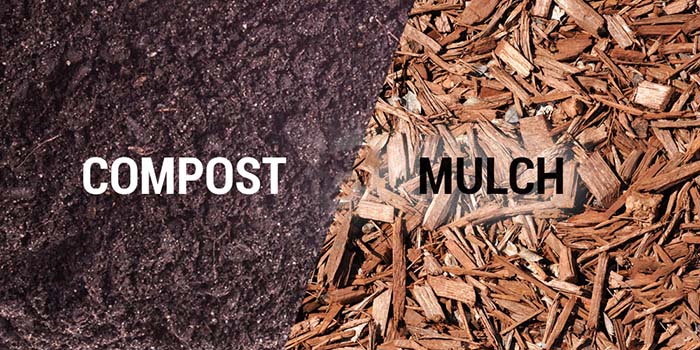
Compost and mulch are gardening terms that are so often used interchangeably that many people think they are simply two different words for the same thing. Image source: jainsusa.com
You can purchase compost at your local gardening center or make it at home in a backyard composting bin or pile. Composting is as simple as collecting yard waste or taking out the organic materials in your trash (such as fruit and vegetable peels, coffee grounds and filters, and eggshells and then corralling them in a pile or bin. Over the course of a year or so, the material will decompose. Compost is mixed into the soil to improve soil structure and add nutrients. Because it is so rich and full of these nutrients, it must be mixed into soil in order for your plants to thrive and should not be used alone. Compost is sometimes referred to as fertilizer or humus.
You can compost food waste, ashes, grass clippings, weeds, eggshells, coffee grounds and tea bags, dry leaves and wine corks. Remember that you should not compost animal waste (could potentially add bad organisms), meat, dairy and bones (they will eventually break down, but they will provide a big, smelly invitation for hungry animals), sawdust (as the wood could be treated with chemicals) and cooked rice (can lead to the growth of unwanted bacteria). There are many good articles online about how to create and maintain a compost at home, check them out!
Gardening Tip: Think twice before adding citrus peels, onions, and garlic to your homemade compost pile. It is believed that these materials repel earthworms, which are a vital part of any garden.
To summarize:
- Compost is mixed into the soil; whereas, mulch is spread on top of the soil.
- Compost is best at adding nutrients to the soil and improving soil structure. Mulch is best at limiting weed growth, preventing erosion and retaining soil moisture.
Young trees need mulch just as much as they need good quality compost!
How to make your own mulch at home for free!
Organic mulch comes from materials that naturally break down. Think:
- Wood chips
- Lawn clippings
- Pine needles
- Leaf mulch
- Newspaper
- Compost
- Straw
- Crushed seashells or crushed nut shells
Avoid using the leaves from walnut and eucalyptus trees, as these can prevent other plants from growing.
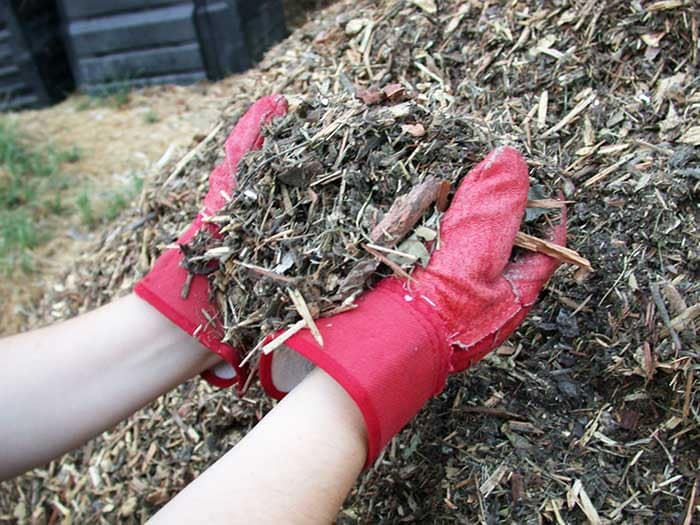
Organic mulches include formerly living material such as chopped leaves, straw, grass clippings, compost, wood chips, shredded bark, sawdust, pine needles, and even paper. Image source: Dvortygirl / Creative Common license
For your DIY mulching, we recommend starting with what materials you have based on the season.
Some organic mulch is ready to put directly on the base of your tree such as straw, grass clippings and pine needles (as long as you don’t use chemical treatments on your lawn—like herbicides or pesticides). The same goes for compost. When your compost pile transforms into that deep rich black hue, remove any weeds growing in your pile and layer the mulch at the base of your tree.
Other organic mulch needs a bit of prep. The best way to mulch leaves is to wait for the pile to dry and run the leaves through your mower once or twice, preferably with a bag to catch the clippings. For things like branches and bark, gather loose pieces of wood into small piles during spring lawn cleanup, removing any rocks as you go. You can usually rent a wood chipper from your hardware store if you don’t already own one. After checking out the instructions—and putting on those safety glasses—grind up the wood into small-to-medium flakes.
When and how to apply mulch
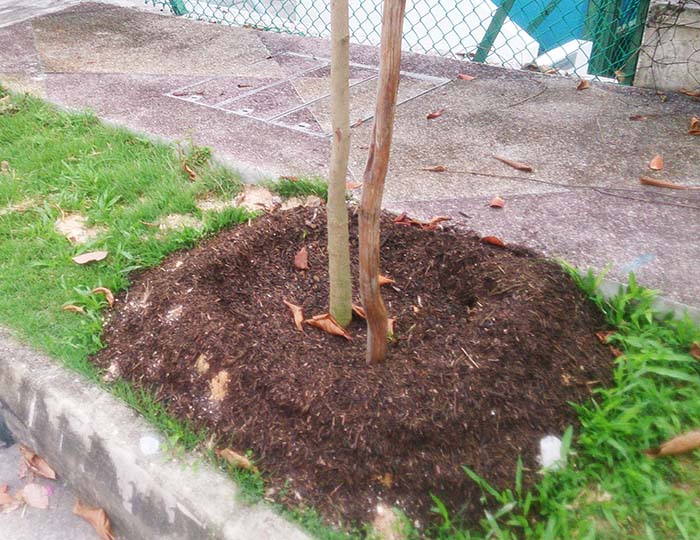
The recommendation is to aim for a doughnut shape and not a volcano shape around the base of your tree. Image source: Mokkie / CCo
Did you find it informative to read about why young trees need mulch? Do you have anything to add? We would love to hear from you in the Comments section below!
To keep up to date with all the latest Bios Urn ® news and stories, you can follow us on Facebook, Instagram, Twitter, Pinterest and YouTube!
Join our mailing list to keep you updated of all Bios® news and get a 10% Discount!


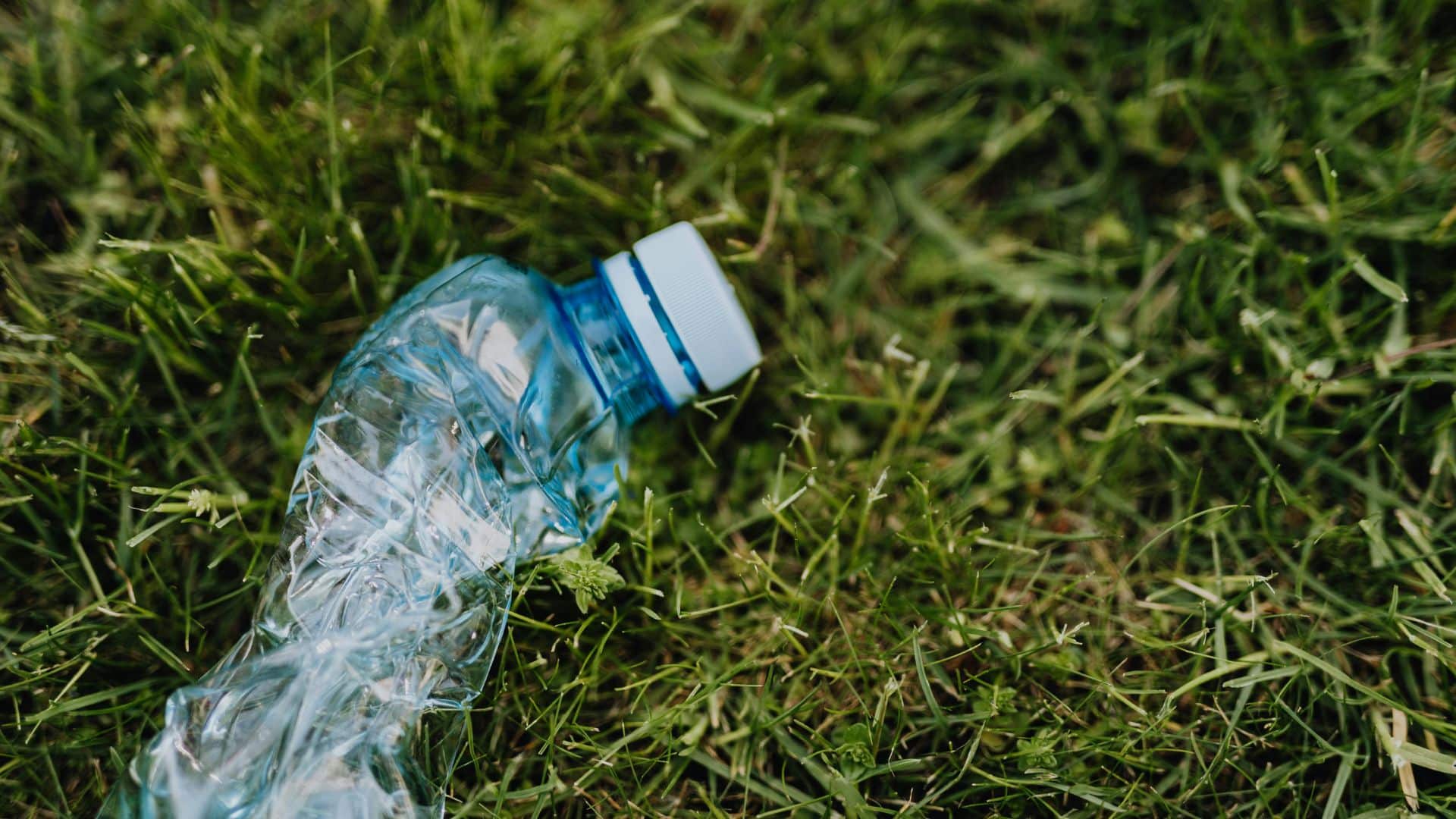





This was a very helpful article, Thank you for informing us of the difference between the three matters. I have one question, is it advisable to put mulch on an indoor tree that you have chosen for the the bios urn and planter. Thanks
Hi Helen! We are glad you found the article useful. And you raise a really good point about whether to mulch or not with indoor plants. Yes, indoor plants can benefit from a layer of mulch in much the same way.
Mulches for houseplants, unlike outside mulch, can be made from both natural and artificial substances. Mulching your indoor plants will keep them hydrated and healthy longer. Using alternative items for mulch, like marbles, pecan shells or pebbles, is also an easy means of reusing and recycling. Mulches made from heavier materials, like pebbles, won’t blow away if the plant is placed by an open window. Nutrients like nitrogen release into soil as mulches made from natural materials, like a mix of wood chips and leaves, break down, acting as a form of plant food.
Layers of mulch for houseplants should be fairly thin, allowing for proper air circulation and preventing plants from becoming overly humid and moist, which allows bacteria to thrive.
Watering a mulched houseplant requires a few extra steps. When mulch covers the soil, it’s easy to overwater plants. To avoid this problem, move mulch aside for a moment, exposing the soil so you don’t overdo it with the watering can. Make sure plants have proper drainage too. Containers with holes in the bottom allow extra water to run out, so it doesn’t become trapped and result in waterlogged roots. Best to use indoor pots with drainage holes and saucers underneath.
A good indoor potting mix is usually composed of peat moss, vermiculite and perlite. These soilless mixes absorb moisture very well and resist compaction, but they tend to dry out very quickly. Since they do not contain any nutrients, you should also provide your plants with a consistent supply of fertilizer.
We hope this gives you clarification! Let us know if you have any more questions. Thank you
Because container plants need to be repotted every several years, mulch needs to be easily removed and replaced. Mulch made of wood chips is probably the best type to use. Pebbles are attractive and may be good for your plant containers, but take care during repotting so they don’t get mixed into the potting soil.
Tip: Protect your plants from damage by keeping mulch 3 inches away from stems. Mulch should be 2 to 3 inches deep.